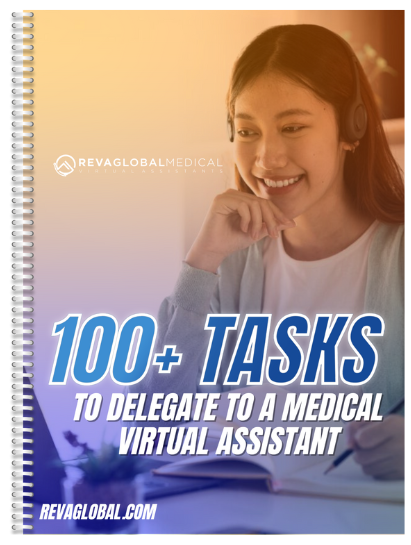Everything a Medical Transcriptionist VA Can Do—So You Don’t Have To

In today’s healthcare environment, physicians, practice managers, and healthcare administrators are constantly balancing patient care with administrative demands. One of the most time-consuming, yet mission-critical tasks is medical transcription. That’s why many practices are turning to a Medical Transcriptionist VA—a virtual assistant trained specifically to handle medical transcription with speed, accuracy, and HIPAA compliance.
A Medical Transcriptionist VA (Virtual Assistant) is a remote team member who specializes in converting dictated audio or handwritten notes into properly formatted, structured documentation within electronic health record (EHR) systems or practice management software. More than just a typist, they are trained professionals who understand medical terminology, documentation protocols, and industry compliance standards.
Whether you’re in private practice or managing multiple providers across locations, hiring a Medical Transcriptionist VA allows you to delegate critical documentation work—freeing up hours each week for more meaningful clinical activity.
Why Medical Transcription Is Crucial for Healthcare Practices
Accurate documentation plays a foundational role in every aspect of a healthcare operation. From patient safety and quality of care to reimbursement and malpractice protection, the way patient encounters are recorded matters deeply. Yet, many providers struggle to keep up with transcription demands, especially when balancing full schedules, telehealth visits, and compliance requirements.
A Medical Transcriptionist VA fills this gap by ensuring clinical notes are completed promptly, with the correct formatting, and aligned with the provider’s unique style.
Core Responsibilities of a Medical Transcriptionist VA
Let’s dive deeper into the actual scope of work a Medical Transcriptionist VA performs on a day-to-day basis:
1. Transcribing Voice Dictations
The primary function of a Medical Transcriptionist VA is to listen to dictated notes from healthcare providers and convert them into written medical records. These can include:
-
Progress notes
-
Consultations
-
History and physical (H&P) reports
-
Discharge summaries
-
Referral letters
-
Operative reports
The VA receives these recordings securely (via apps, file uploads, or integrated EHR tools) and transcribes them into clear, accurate documentation. Their training in medical terminology ensures they can distinguish between complex terms, acronyms, and context-specific phrasing.
2. Real-Time Documentation (Live Transcription Support)
Some Medical Transcriptionist VAs offer live transcription or scribe support during telehealth or in-person patient appointments. In this setting, the VA listens in and transcribes the conversation in real time—entering notes directly into the EHR or clinical note template.
This approach allows the provider to stay focused on the patient, rather than toggling between screens or typing notes mid-consultation. It also accelerates charting turnaround and reduces after-hours admin work.
3. Formatting and EHR Data Entry
Transcription isn’t just about typing—it’s about organization. A Medical Transcriptionist VA ensures that all transcribed content is formatted correctly based on:
-
Practice-specific templates
-
SOAP or APSO note structures
-
Specialty-specific formatting (e.g., orthopedics, cardiology, internal medicine)
-
EHR platform protocols (Athenahealth, Kareo, eClinicalWorks, Epic, etc.)
The VA is responsible for inputting the final transcription into the correct patient chart within the EHR system, ensuring accuracy in headings, spacing, bullet points, and order of information.
Streamline your practice with a Medical Virtual Assistant
By utilizing a Medical Virtual Assistant, you can free up your time and ensure that your medical practice operates efficiently
4. Proofreading and Quality Assurance
One of the often-overlooked skills of a Medical Transcriptionist VA is their attention to detail. Before submission, they review each document for:
-
Grammar, spelling, and punctuation
-
Medical terminology accuracy
-
Inconsistencies in vital signs, medications, or treatment plans
-
Missing elements like diagnoses or physician signatures
This level of quality assurance is critical to avoid documentation errors that could affect patient outcomes or claims processing.
5. Managing Transcription Turnaround Time
Quick turnaround is essential—especially when patient volumes are high. A Medical Transcriptionist VA works under defined timeframes to deliver completed notes within 12 to 24 hours, depending on the volume and complexity.
Having a VA dedicated solely to transcription ensures consistent delivery, reduced backlogs, and more efficient patient follow-up.
6. Indexing and Organizing Documentation
Beyond transcribing, a Medical Transcriptionist VA is responsible for correctly labeling and organizing documents within the practice’s digital ecosystem. This can include:
-
Assigning correct filenames and document types
-
Sorting files into the appropriate patient folders or categories
-
Creating cross-referenced notes for specialists or referrals
-
Ensuring date and provider information are accurate for auditing purposes
These organizational tasks streamline future access to records for providers, billing teams, and compliance audits.
7. Supporting Medical Billing and Coding
While not directly responsible for coding, a Medical Transcriptionist VA ensures that all clinical documentation includes the necessary elements for proper coding. This supports the billing department in:
-
Assigning appropriate CPT and ICD-10 codes
-
Justifying claims with clearly documented medical necessity
-
Reducing denials due to incomplete documentation
Their accurate and detailed notes are the foundation of successful revenue cycle management.
8. Following HIPAA Compliance Protocols
Patient confidentiality is a top concern in healthcare—and transcription is no exception. A trained Medical Transcriptionist VA operates with strict adherence to:
-
HIPAA data privacy and security standards
-
Secure communication and file-sharing protocols
-
Proper handling of protected health information (PHI)
Many providers choose to work with agencies that pre-train their VAs on compliance protocols, ensuring peace of mind and regulatory adherence from day one.
9. Customizing Workflows to Fit Your Practice
No two practices operate exactly the same—and that’s why Medical Transcriptionist VAs offer flexible support tailored to your workflow. They can:
-
Use your preferred dictation software or platform
-
Follow physician-specific preferences for note structure or language
-
Create templates to standardize documentation across providers
-
Collaborate with internal team members or medical billing staff
Whether you need support five days a week or just a few hours per day, a VA can scale their involvement to meet your needs.
10. Improving Practice Efficiency Over Time
Once a Medical Transcriptionist VA becomes familiar with your style and systems, their productivity increases—resulting in faster turnaround, cleaner documentation, and fewer edits. Over time, this can lead to:
-
Improved documentation quality scores
-
Enhanced patient follow-up and care coordination
-
Reduced documentation-related stress among providers
-
Greater overall operational efficiency
They also contribute to more consistent documentation, which is vital for audits, legal protection, and quality metrics.
Is a Medical Transcriptionist VA Right for You?
If you or your team are experiencing any of the following, it may be time to consider hiring a Medical Transcriptionist VA:
-
Spending too much time on EHR documentation
-
Backlogs of charts waiting to be completed
-
Errors in patient records due to rushed notes
-
Delays in insurance reimbursements
-
Burnout from after-hours transcription work
With a trained and reliable VA handling this essential task, you free up your team’s time, improve care delivery, and protect the integrity of your clinical documentation.
Getting Started with a Medical Transcriptionist VA
The onboarding process for a Medical Transcriptionist VA is often quicker than you’d expect. At REVA Global Medical, we match healthcare practices with trained, experienced virtual assistants who specialize in transcription, documentation, and EHR systems.
Here’s how it works:
-
Discovery – We learn about your transcription volume, EHR, and workflows
-
Matching – You’re paired with a VA trained in your specialty
-
Onboarding – We walk you through communication, software, and scheduling setup
-
Support Begins – Your VA starts transcribing and integrating into your workflow
There’s no need to hire in-house or spend time training from scratch—we handle that for you.
Transcription is one of the most essential—but often overlooked—components of a healthcare practice’s success. When it’s handled efficiently, providers can stay present with patients, billing teams have the data they need, and practices avoid costly errors.
A Medical Transcriptionist VA offers a practical, affordable way to manage this process. They bring technical skill, clinical understanding, and compliance awareness to the table—giving your team the support they need to thrive.
If documentation is slowing you down, it’s time to delegate. Your practice deserves it. Your patients deserve it. And your evenings? You can get those back too.
Ready to streamline your documentation?
👉 Learn more about hiring a Medical Transcriptionist VA at revaglobalmedical.com
Schedule Your Strategy Session!
Grow Your Brand With Trained Virtual Assistants
Get the help you need to take your brand and business to the next level.
Not Sure What Tasks To
Start Outsourcing?
We’ve got you covered.
Download our free guide to help you get started.


